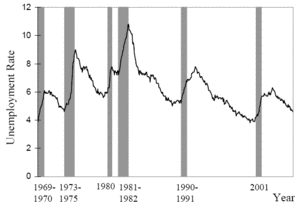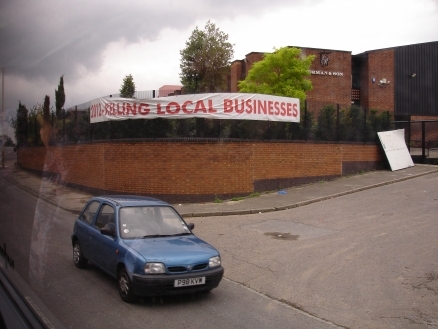Types of unemployment
| Topics: |
Government agencies often are concerned with calculating the numbers of the unemployed, while economists are more concerned with the causes of unemployment. Economists often apply a three-way categorization of types of unemployment that are helpful in thinking about some of the major causes of unemployment.
Contents
Frictional Unemployment
Frictional (or search) unemployment merely reflects people’s transitions between jobs. The fact that some people are unemployed does not necessarily mean that there are no jobs available. In April 2006, for example, while 7.0 million people were looking for jobs, there were also an estimated 4.1 million job vacancies—that is, jobs looking for people! Even in a well-functioning economy, it may take many weeks for people and suitable jobs to find each other. An unemployment rate of 0% could only happen if everyone who wants a job always takes one immediately—within a week. Not only is this unlikely, this is also in some ways undesirable. Taking the first job offered is often not the best thing for the person looking for the job, nor for the economy as a whole. Everybody benefits if people take the time to find good job “matches”—places where their skills and talents can be put to valuable use. Because information about job openings takes time to find, and employers may want to spend time interviewing and testing applicants, making a good job match is not an instantaneous process.
For the most part, economists don’t worry too much about frictional unemployment, because some amount of frictional unemployment—say, 2-3%—is inevitable and much of it tends to be short-term. Things like innovative web technologies for matching job offers to job seekers may reduce frictional unemployment by reducing search time.
Many job seekers rely on state unemployment insurance programs to ease their income needs while they spend time searching for work. Unemployment compensation benefits are, in many states, set equal to half a worker’s earnings or a state-set maximum (whichever is less). Workers who qualify can usually receive benefits for up to 26 weeks. Part of the justification for these programs is to allow people the time to make good matches.
Structural Unemployment
Structural unemployment arises in an economy when a mismatch occurs between the kinds of jobs being offered by employers and the skills, experience, education, and geographical location of potential employees. One important cause of structural unemployment is sectoral shifts, where employment in some sectors falls while employment in other sectors rises. The U.S. economy may have a lot of new jobs for financial analysts and nurses aides in the Southwest, for example. But these won’t do you much good if you live in the Northeast and have skills in engine assembly or web design.
On the positive side, structural unemployment arises from what economist Joseph Schumpeter (1883-1950) called “creative destruction.” Schumpeter thought this was a good and necessary thing for capitalist economies. Technological and entrepreneurial innovations have often contributed to improved living standards, even though they cause some job opportunities to dry up. People skilled in outdated technologies—buggy-whip manufacturing is a classic example—necessarily become unemployed. Society could have tried to prevent unemployment in buggy-whip manufacturing by banning the introduction of the automobile, but the cost in economic growth would have been immense. If we, today, begin to move away from internal combustion engines due to their negative environmental impacts, the conventional auto industry will decline just as the buggy-whip industry declined at the end of the horse-and-buggy era. New technologies, new markets, and new concerns create new opportunities.
On the negative side, shifts in employment patterns by sector and industry are very disruptive, and often very painful, to the people who work in the declining sectors and to their families and communities. People in the declining sectors see the value of their specialized human capital depreciating rapidly. Whole towns and cities may become economically depressed when a major industry closes down, since the unemployed workers spend less at local businesses and property values plummet. Displaced workers may be able to train for a new career—especially if they are young and able to move to wherever the new jobs may be. But many displaced workers, particularly older ones, may never find the kind of pay and satisfaction that they had at their earlier occupations. Older displaced workers are more likely than younger ones to stay unemployed for long periods, or exit the labor force.
Governments at all levels have tried various policies to prevent or alleviate structural unemployment. The governments of some countries, notably Germany and Japan in the 1980’s and 1990’s, have followed industrial policies through which they directly encourage the development and retention of certain key industries through loans, subsidies, and tax credits. During negotiations on international trade, one sensitive issue is always the impact that increased trade might have on the employment levels in various industries in each country.
Government policies in the United States that target structural unemployment often focus on attempting to help displaced workers find new employment. For example, the Trade Adjustment Assistance Reform Act of 2002 provides benefits for certain worker displaced as a result of increased imports or the shifting of production to other countries. Workers who qualify for the program can receive retraining along with temporary income support payments and assistance with health insurance. The key feature of these programs is that they are targeted to particular workers, in particular sectors of the economy. There has been some question, however, as to whether they have actually been successful in getting displaced workers into new, good jobs. Business policies at the firm level are also relevant: firms can help prevent structural unemployment if they make retaining and/or retraining their loyal employees a priority, even while responding to changes in technology and trade.
Cyclical Unemployment

Cyclical unemployment is unemployment due to macroeconomic fluctuations—specifically, unemployment which occurs due to a drop off in aggregate demand. During recessions, unemployment rises as demand for the products of business falls off. During recoveries, this kind of unemployment should decrease.
Traditionally, a recession has been defined as a case where gross domestic product (GDP) falls for two consecutive calendar quarters. Most economists look to the National Bureau of Economic Research (NBER), a nonprofit and nongovernmental economic research organization, to "officially" mark the beginning and end of recessions. The NBER determinations are strongly based on GDP data, though they also look at other indicators such as the levels of industrial production and wholesale-retail sales.
Figure 1 shows the monthly unemployment rate in the United States from January 1969 to May, 2006. Unemployment was at a low of 3.4% in 1969, and at a high of 10.8% in 1982. Notice in the figure that since 1982 the U.S. economy has apparently been characterized by less frequent and shorter recessions. However, while earlier recovery periods were characterized by immediate upswings in employment, the recessions that NBER says ended in 1991 and 2001 were followed by continuing job slumps. The continued loss of jobs well into 2003, after the last recession, caused many commentators to call it the “jobless recovery.” Apparently, while GDP grew, it grew too slowly to provide jobs for new entrants and keep up with increasing labor productivity. Is an economy really “recovering” if employment is still dropping or stagnating?
Not surprisingly, given that the field of [[macroeconomic]s] was born out of the problems of the Great Depression, cyclical unemployment is of major concern to macroeconomists. While structural unemployment affects only some sectors of the economy and some amount of frictional unemployment seems inevitable, cyclical unemployment is spread broadly through the economy and can cause considerable economic hardship. For this reason, it seems that avoiding or minimizing cyclical unemployment should be an important goal of economic policy.
Further Reading
- Global Development And Environment Institute, Tufts University
| Disclaimer: This article is taken wholly from, or contains information that was originally published by, the Global Development And Environment Institute. Topic editors and authors for the Encyclopedia of Earth may have edited its content or added new information. The use of information from the Global Development And Environment Institute should not be construed as support for or endorsement by that organization for any new information added by EoE personnel, or for any editing of the original content. |
